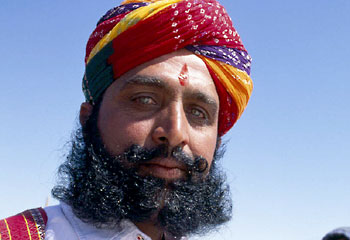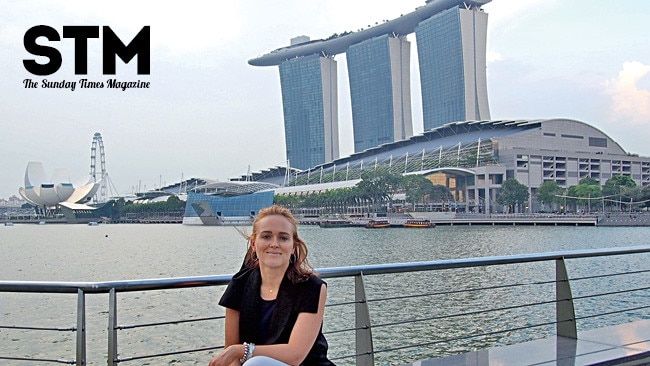Going with the mo
IN Rajasthan a moustache is seen as an index to the real man, and the coveted Mr Desert title is to die for, writes Kevin Pilley.

PROFUSE facial hair has made L.N. Bissa a rich and famous man. It has also made him enemies.
But in the cut-throat world of professional moustache-growing and showing, close shaves with sudden and violent death come with the territory. Some people will do absolutely anything to get their moustache on television.
In Rajasthan, a talented and ambitious moustache – if handled correctly – can be big business, leading to all the trimmings of celebrity status: endorsement deals, personal appearances, lucrative modelling contracts, world travel, adulation and, of course, professional envy.
A well-managed moustache can lift a poor Indian and his family from the gutter. But it can also leave him there.
Bissa's father probably died because of his body hair. No one really knows. Six years ago he was found decapitated in a ditch. His murderers have never been caught and the whereabouts of his head and his famous 1.3m Guinness Book of Records moustache and goatee remains a mystery. Someone wanted his 'tache terminated. It was getting in the way.
After his father's death, Bissa Jr has dominated the world of semi-professional competitive moustache-growing in India, winning the coveted "Mr Desert" title for a record five years in a row before hanging up his hairs while they were at the top.
A moustache is a complex symbol in India. No self-respecting man should be without one. It is a badge indicating ethnic grouping and regional provenance.
A Hindu moustache tends to curl upwards. A Muslim moustache droops.
A moustache is seen as an index to the real man, a revelation of his essential qualities. To criticise a Rajasthani's moustache is like going to the Royal Easter Show dairy section and criticising someone's best cow. It questions their whole purpose on the planet.
Several moustache contests are held every year in Rajasthan. They attract huge crowds.
The Mr Desert tournament is easily the most prestigious. It is held every February during the Jaisalmer Desert Festival on the edge of the Thar wilderness. This year 30,000 packed into the Poonam Stadium to watch the coronation of Mr Desert.
The contest is part beauty pageant and part pentathlon. Each of the 10 contestants competes in two days in six disciplines: moustache growing, turban tying, charisma, beauty, camel riding and camel decoration. These skills are believed to express the qualities of the New Desert Man.
For aspiring Mr Deserts, Jaisalmer is a serious event for which they have been grooming themselves for years. It is the "Crufts of Tufts".
Great lengths have been taken to ensure that their moustaches are at the peak of their powers. Being rich in essential moisturising polymers, camel dung apparently keeps the shape and sheen of a competition moustache through several washes.
Looking for body and shine as well as a moustache which projects the desired masculine virtues of chivalry, loyalty and independence, the female judges gave the contestants a thorough and expert inspection before awarding the coveted Karan Beel Moustache Trophy to local Border Forces security officer and pre-contest favourite, P.C. Sodha.
Like a moustache, the biggest turban is not necessarily the best. It is what you do with it that counts. Through his turban a man can show his true colours.
Each group has its own way of tying a turban. Muslims leave one end loose on their shoulders. Hindus leave the end hanging down.
Colours indicate moods. Orange is a happy colour. Brown, blue and green are sad. Red is worn by lovers.
Sunil Parahit, a 32-year-old civil servant, had earlier won the evening dress and charm section. His moving compulsory three-minute speech entitled "Why I love the desert" had won over the gushing judges.
But in a blur of dyes and flailing cotton, it was P.C. Sodha who set a turban-tying speed world record with a full wrap timed at 3.42 seconds. It was wind unassisted.
Day Two of the contest began with the camel decoration event. Customising camels is a popular hobby in the region and the DIY designs were televised live through the subcontinent to families eager for tips on refurbishing their own beasts of burden.
A well-appointed camel, like a well looked after beard and a snazzy turban, clocks up a lot of Brownie points in terms of social status.
While the track was prepared for the final competition – the camel dash – the crowd was treated to a performance of what was billed as "an elephant gymnastic and acrobatic display team" which performed its own highly stylised manoeuvres and some fairly low-speed formation lolloping.
The curtain-raiser over, competitors were led into the saddling enclosure. The jockeys mounted and lined up. The starter dropped his flag and, in an explosion of choking desert dust, they were off down the track.
The crowd went mad although no one knew the result because no one could see a thing through the dust.
Eventually P.C. Sodha was awarded first place. The winning distance was given as "a short neck and a row of double eyelashes". The crowd went berserk and flocked around their new champion.
The new Mr Desert was crowned and presented with his 1001 rupee cheque by the legendary L.N. Bissa. The police fought back angry crowds. The disappointed wannabes walked away. Their face would not be appearing on postcards on advertisements this year.
Many of them had the hump.



